
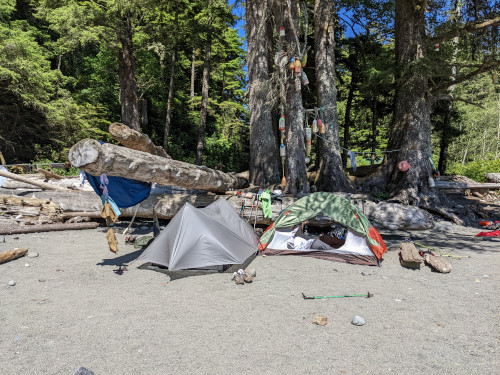
More Miles = More Smiles is typically how a long hike goes. As long as there's daylight, the feet are moving and the next beautiful view is anticipated ahead on the trail. There is very little time spent sitting around a campsite - basically make dinner and head to bed for an early start on the next day.
As I mentioned earlier, the West Coast Trail is not a typical long distance trail. At only about 50 miles, it's a bit longer than most backpacking trips, but much shorter than most long trails (which tend to be at least hundreds of miles). This means, unless you are fastpacking or trying for an FKT, you tend to have shorter hiking days and more time in camp.
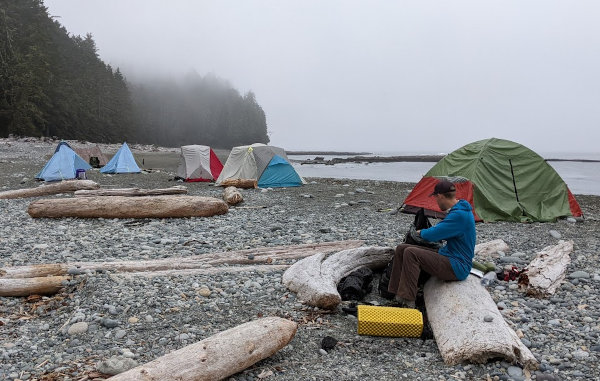
I'd like to share what our In Camp time was like on our trip, and hope it provides some insight and ideas for you planning a future West Coast Trail hike.
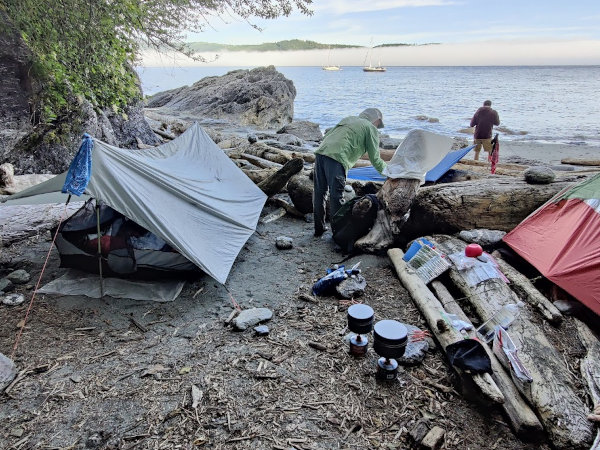
With a 5 kilometer hike from Gordon River to Thrasher Cove on our first day, even with a very late 11:15am start time after our mandatory orientation, we got to camp before 4:30pm. This would actually be our latest camp arrival time for the whole trip. Being in the 2nd group of 10 people ferried across the river, the campsite was already fairly crowded when we arrived even though we passed a few groups on the way. The photo above is of our first setup and it shows most of the important parts of our camp life.
Our Shelters - We had three different shelter styles. One person slept in a bivy sack with a silnylon tarp above him to keep off the heavy morning dew. Another two had a stand-alone tent with poles and rain fly. My wife and I had a tarp with a bug nest underneath.
All three shelters worked just fine, but a few things about them:
- the bivy takes up very little space and can be laid down between logs or rocks, or anyplace you can find.
- dome tents with poles can be pitched anywhere and really need no stakes, so sand is no problem.
- a tarp that requires separate poles needs stakes which can be a nuisance in soft sand. There were always drift logs or rocks available to help with the guylines, so it was not a problem.
- Morning dew was heavy many days. Having a rag, sponge, or bandana to sop most of the water off your shelter is a good idea.

Our Water - When I thru-hiked the Arizona Trail, finding enough water was an ongoing concern. The West Coast Trail has water everywhere! Since the trail follows the shoreline of Vancouver Island, hikers are constantly crossing small streams carrying water down from the small mountain range to the ocean. I never carried more than my single .6 liter bottle full of water, and every campsite is situated on a major river or creek.
We used two Sawyer Squeeze filters to treat all our water and they worked very well. At each camp, someone would take our three 2-liter dirty water bags to the water source, fill them, and carry them back to our campsite. Then, anyone that wanted water could attach the Squeeze filter to a bag and fill their water bottle from that. We would use the rest for dinner.
After dinner, someone would repeat the water source trip to get water for the next morning. By filling water bottles at night, while you have free time, the water can cool off more in the cold air overnight and time is saved in the morning.
Typically, we'd have a water refill and rest break once during the morning at some stream we passed. All the water sources were fine, but we were probably overly cautious at one...

At Walbran Creek, the historic water source seems to be a trickling waterfall on the east side of the creek a few hundred yards upstream from the camping area. Unfortunately, there has been a landslide there blocking access to the source. So, most people were just gathering water out of the lagoon that you can see in the background above. You can also see someone standing in the water just behind us. People were swimming, bathing, washing dishes, and I presume peeing in that water. So, we gathered all our water bottles into a large mesh bag along with our water filter and headed farther upstream. When we hit the landslide blockage, we swam across to the other side. About a quarter mile farther upstream, the lagoon ended and the stream had riffles and obvious flowage so we gathered our water there. Working our way back downstream with about 20 pounds of water over very slippery underwater rocks was quite an adventure, but at least we got good, clean water.
Also, at Tsusiat Falls camp area, I'd recommend getting water directly from the falls rather than from the outflow of the pool below it since many people bathe there. But, if no one has been in the water for some time, like early in the morning, I suppose any crud as been washed downstream.

Our Food - We really enjoyed how well our dinners worked out! We kepy things Super Simple!
Earlier this summer, on a backpacking trip in Wyoming, my buddy had made his own freeze-dried meals and they looked great. So, we purchased dried ingredients from Mother Earth Products (the best buys we could find online) and put together our own. Actually, my wife did pretty much all of it. She also purchased a tiny, inexpensive vacuum sealer and reusable bags. She added all the ingredients for one meal to a bag, closed it, and vacuumed the air out - presto! just like those $$$$ meals.
Our meals were:
- Chicken Tater Trasherole - chicken, mashed potatoes, hash browns, milk, onion, garlic, ranch dip
- Health Bowl - rice, lentils, almonds, cranberries, vegetable bouillon
- Pesto Veggie Pasta - ramen noodles, TVP, mushrooms, pesto mix, parmesan cheese, mixed vegetables
- Lentil Chili (my FAV!) - lentils, tvp, corn, peas, chili seasoning
- Adobo Chicken - chicken, rice, bouillon, garlic, pepper, soy sauce, vinegar
- Chicken Curry Rice - chicken, rice, raisins, apples, onion, curry, allspice, cinnamon, toasted nuts
The only cooking was boiling water and adding it to the individual bags.
Each person could choose which meal sounded good to them each night.
Clean up was just pouring a bit of hot water into the food bag, swishing it around, and drinking it. We took all the bags home and have washed them out to use on our next hike (we leave in a week).
We had simple non-cook food for breakfast, lunch, and snacks - cocoa, coffee, protein bars, granola bars, home-dried fruit, sausage and crackers, Austin-brand cracker sandwiches, M&Ms, trail mix, and the ever-popular Sour Patch Kids.
One super food item that I'd highly recommend is Pringles in a cardboard can (not a plastic can)! Here's why:
- Pringles are calorie dense at 150 cal/oz.
- They taste great with all that salt and crunch.
- They don't get crushed in a backpack.
- It's easy to share a can. We ate a can each day between the five of us.
- Put the lid on an empty can and squeeze the can quickly - it POPs the lid off for endless entertainment.
- The can makes an awesome garbage can when empty. You can pack wrappers and trash in it and it Will Not Break. I packed all my trash for the six days into a can and had room left.

In the photo above, you can see our cooking set up. The constant wind on the ocean meant we used wind blocks to save fuel. We had two canister stoves just so we would have boiling water for everyone at the same time - one stove would have been fine. You also might notice a Mountain House meal - one of us picked that up in a hiker box at the Crab Shack on Nitinat Narrows, so check there for free food when you hike through.
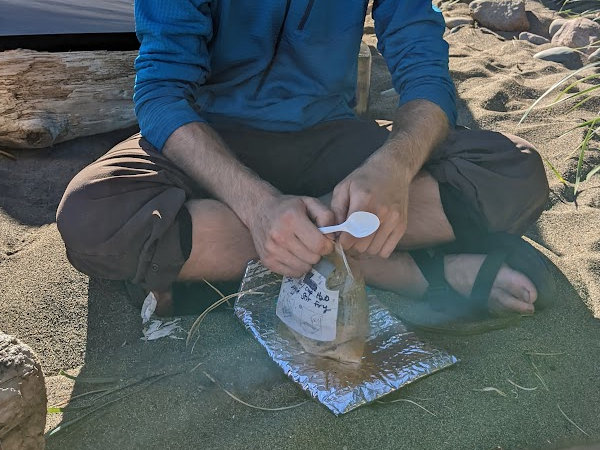
Once hot water was added to the meal pouches, we closed them and set them into individual Cozies that I made from insulating wrap. In less than 15 minutes, they were ready to eat and still very hot. These cozies are simple, cheap, and easy to make.
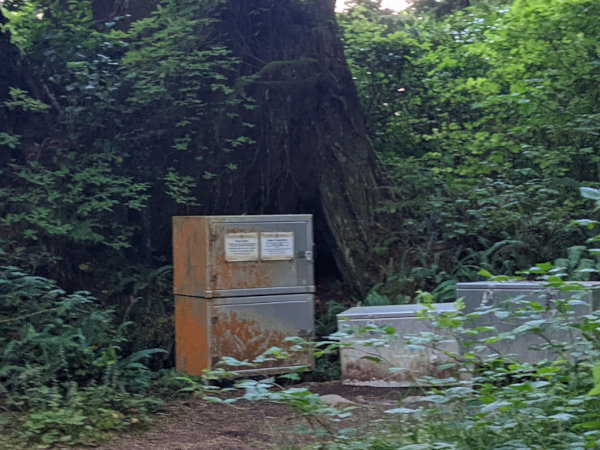
House Rules - If you are used to wild camping in the wilderness, or established camping in a park, the West Coast Trail has a few unique characteristics that puts it somewhere between the two. Reading the official paraphernalia from Parcs Canada will give you all the rules and guidelines, but some of the things I noticed were:
- Food Storage - We had a bear walk onto the beach out of the forest about 20 yards from our tent. Many other campers reported bear sightings. For this valid reason, every campsite has a group of bear containers in which campers should store their food, garbage, and smellables over night. The cans get packed full, so your crackers will probably get crushed. We also saw tracks of smaller rodents often on the beaches, and many mornings showed tiny mouse tracks completely covering every inch of wet sand in our camping area.
- Beach Camping - When you are right on the ocean's edge, things work a bit differently than inland...
- Tides - make sure your campsite is high enough that the incoming tide doesn't reach you. The high tide line is usually easy to see since the sand above it is covered with debris.
- Sand Bugs - There were no mosquitoes, flies, or ticks, but the sand is filled with tiny insects eating the washed up plant life. We got no bites from them, but maybe?
- Wet Sand - The sand at many camps is very fine and soft. When dry, it feels nice, but it gets into any crack, crevice, or open zipper. When wet, like from dew every morning, it sticks to everything. So, step carefully and wipe off lower legs and feet before going to bed and putting on shoes. And, keep things closed up and covered.
- Shelters - I mentioned before that you'll need to figure some way to anchor your tent using rocks or driftwood.
- Night Life - There are dozens of people packed into small sections of beach every night so courtesy is important.
- Campfires - I'm not used to having campfires, but there were a handful up and down the beach. Most areas were denuded of small driftwood for fires and people walked a long distance to scavenge wood. The brochures instructed to keep fires below the high tide line, but that rarely happened. Some beaches were covered in chunks of blackened wood and coal bits.
- Noise - The sounds of the ocean drown out most camper noise, but it's still nice to quiet down when the sun sets. We only had one instance of youth playing loudly next to our tents while we were trying to get to sleep and it didn't last long.
- Sleeping - I typically get up during the night when camping, but I slept straight through every night on the WCT. So, I didn't get to see any stars or night scenery. I think the soft sand makes for a very comfortable bed.
- Sewer - The guidelines say to bathe and wash dishes in the ocean or river mouths emptying into it. In other words, the ocean is the sewer out here. This is atypical to most Leave No Trace principles, but I guess dilution is a solution to pollution. Every evening, we walked down to the ocean edge to brush our teeth and spit into the waves. It was kinda fun. Fortunately, we had no dishes to wash with our meals.
- Toilets - No need to dig catholes on the West Coast Trail! The campsites have composting toilets - with yet more ladders to climb. You climb up, go inside, close the door, do your business, and then toss a handful of wood chips down the hole. That last part is important to make them work!
Since so many people all use the same door handle and ladders, washing your hands and using some alcohol sanitizer afterward is a very good idea.
It's ok to just swing by a campsite and use the toilet during the day, too.
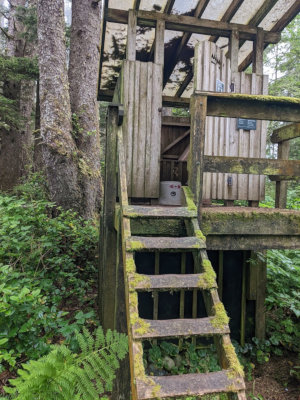

Free Time - Being 2 hours behind our normal time, we woke up pretty early and were on the trail between 6 and 7 each morning. Some of this was also because we had to match the tides to do all the beach hiking we could. This meant we arrived at most camps around 1pm with our latest time being 4:20pm. All the free time is unusual for a long distance hiker since daylight is normally used for hiking.
We got to explore pretty much all the area around the camps. The tide pools and creeks were interesting, and the view out over the ocean was always changing. We saw some whales, otters, boats, and birds.
I spent a little time carving a buoy that was found on the beach and left at Michigan Creek. I also balanced a few long logs across other logs just for something to pass the time. Setting up camp, drying clothes, making meals, and resting took up the rest of the time.
Read the day-by-day of our adventure in my West Coast Trail Journal
Next: BRT & SHT Adventure
archives: 2025 2024 2023 2022 2021 2020 2019 2018 2017 2016 2015 2014 2013 2012 2011
Find more Hiking Resources at www.HikingDude.com


Follow Me
Recent Comments